Page 6 of 283
TUNDRA (34413U)
6
Indicator symbols on the instrument panel
Seat belt reminder light*1
Low oil pressure warning light*1
Low fuel level warning light*1
Brake system warning light*1
Discharge warning light*1
Malfunction indicator lamp*1
Anti- lock brake system warning light*1
SRS warning light*1
(type A)
(type B)
Automatic transmission fluid temperature warning
light*1
Unengaged Parkº warning light*1
Low windshield washer fluid level warning
light*1
Headlight high beam indicator light
Overdrive- off indicator light Turn signal indicator lights
Open door warning light*1
Passenger airbag off indicator light
Automatic transmission indicator lights
ProCarManuals.com
Page 11 of 283
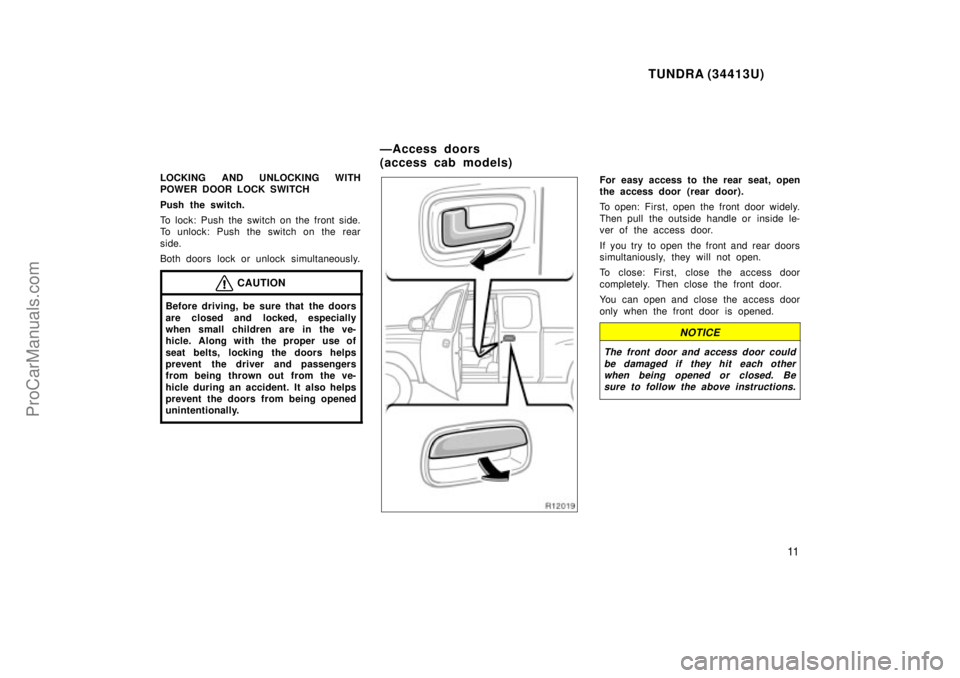
TUNDRA (34413U)
11
LOCKING AND UNLOCKING WITH
POWER DOOR LOCK SWITCH
Push the switch.
To lock: Push the switch on the front side.
To unlock: Push the switch on the rear
side.
Both doors lock or unlock simultaneously.
CAUTION
Before driving, be sure that the doors
are closed and locked, especially
when small children are in the ve-
hicle. Along with the proper use of
seat belts, locking the doors helps
prevent the driver and passengers
from being thrown out from the ve-
hicle during an accident. It also helps
prevent the doors from being opened
unintentionally.
For easy access to the rear seat, open
the access door (rear door).
To open: First, open the front door widely.
Then pull the outside handle or inside le-
ver of the access door.
If you try to open the front and rear doors
simultaniously, they will not open.
To close: First, close the access door
completely. Then close the front door.
You can open and close the access door
only when the front door is opened.
NOTICE
The front door and access door couldbe damaged if they hit each otherwhen being opened or closed. Besure to follow the above instructions.
ÐAccess doors
(access cab models)
ProCarManuals.com
Page 19 of 283
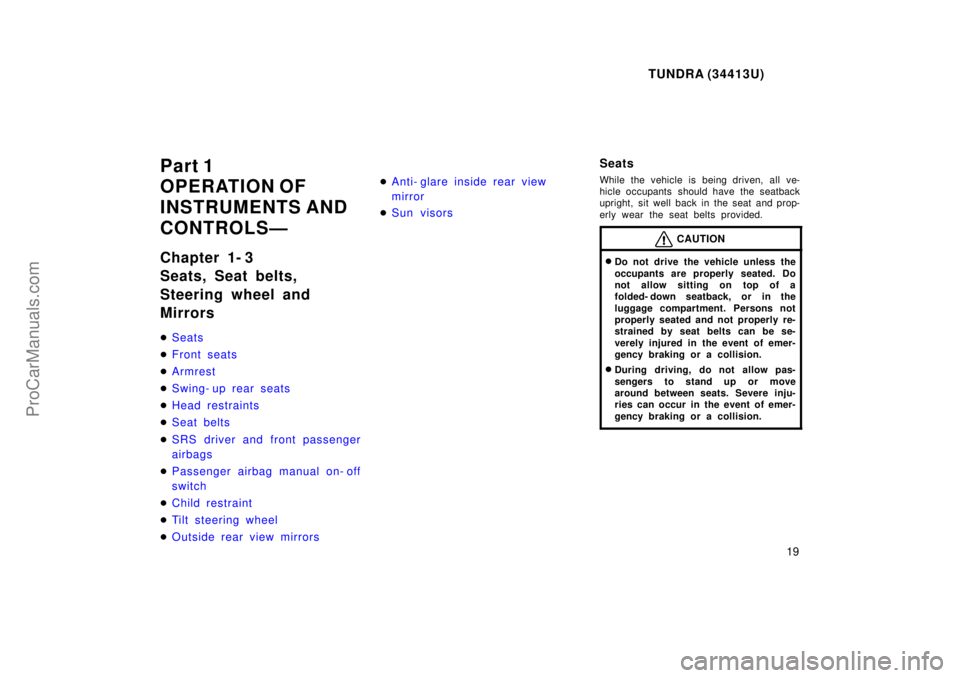
TUNDRA (34413U)
19
Part 1
OPERATION OF
INSTRUMENTS AND
CONTROLSÐ
Chapter 1- 3
Seats, Seat belts,
Steering wheel and
Mirrors
�Seats
� Front seats
� Armrest
� Swing- up rear seats
� Head restraints
� Seat belts
� SRS driver and front passenger
airbags
� Passenger airbag manual on- off
switch
� Child restraint
� Tilt steering wheel
� Outside rear view mirrors �
Anti- glare inside rear view
mirror
� Sun visors
Seats
While the vehicle is being driven, all ve-
hicle occupants should have the seatback
upright, sit well back in the seat and prop-
erly wear the seat belts provided.
CAUTION
�Do not drive the vehicle unless the
occupants are properly seated. Do
not allow sitting on top of a
folded- down seatback, or in the
luggage compartment. Persons not
properly seated and not properly re-
strained by seat belts can be se-
verely injured in the event of emer-
gency braking or a collision.
�During driving, do not allow pas-
sengers to stand up or move
around between seats. Severe inju-
ries can occur in the event of emer-
gency braking or a collision.
ProCarManuals.com
Page 21 of 283
TUNDRA (34413U)
21
Non- split bench seat
1. SEAT POSITION ADJUSTING LEVER
Pull the lever up. Then slide the seat
to the desired position with slight body
pressure and release the lever. 2. DRIVER'S SEAT CUSHION ANGLE ADJUSTING KNOB
Turn the knob either way.
3. SEATBACK ANGLE ADJUSTING LEVER
Lean forward and pull the lever up.
Then lean back to the desired angle
and release the lever.CAUTION
To reduce the risk of sliding under
the lap belt during a collision, avoid
reclining the seatback any more than
needed. The seat belts provide maxi-
mum protection in a frontal or rear
collision when the driver and the pas-
senger are sitting up straight and
well back in the seats. If you are
reclined, the lap belt may slide past
your hips and apply restraint forces
directly to the abdomen. Therefore, in
the event of a frontal collision, the
risk of personal injury may increase
with increasing recline of the seat-
back.
ProCarManuals.com
Page 22 of 283
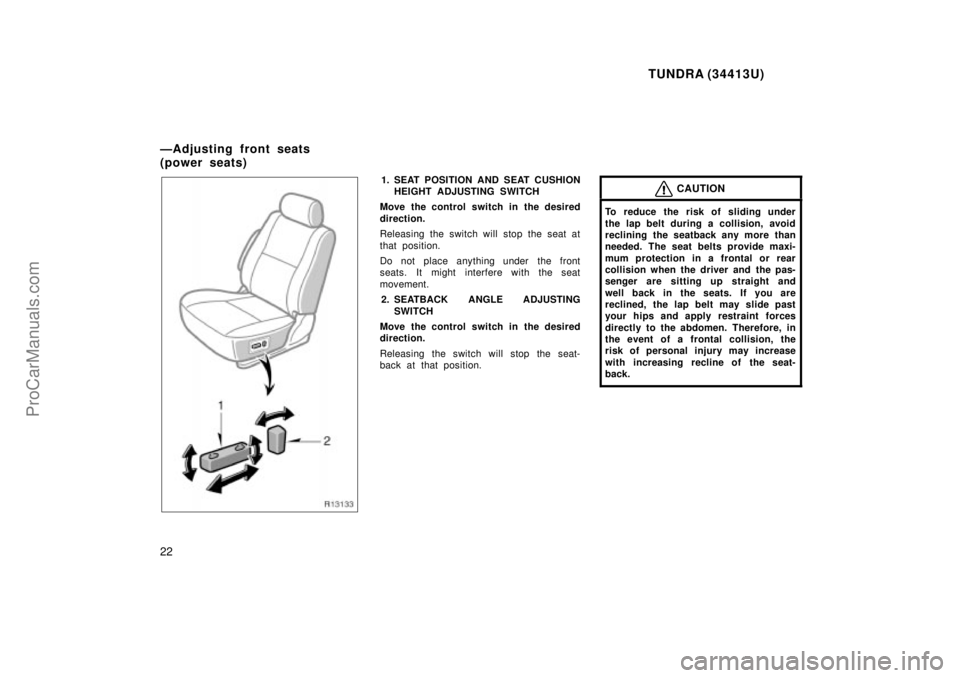
TUNDRA (34413U)
22
1. SEAT POSITION AND SEAT CUSHIONHEIGHT ADJUSTING SWITCH
Move the control switch in the desired
direction.
Releasing the switch will stop the seat at
that position.
Do not place anything under the front
seats. It might interfere with the seat
movement. 2. SEATBACK ANGLE ADJUSTING SWITCH
Move the control switch in the desired
direction.
Releasing the switch will stop the seat-
back at that position.CAUTION
To reduce the risk of sliding under
the lap belt during a collision, avoid
reclining the seatback any more than
needed. The seat belts provide maxi-
mum protection in a frontal or rear
collision when the driver and the pas-
senger are sitting up straight and
well back in the seats. If you are
reclined, the lap belt may slide past
your hips and apply restraint forces
directly to the abdomen. Therefore, in
the event of a frontal collision, the
risk of personal injury may increase
with increasing recline of the seat-
back.
ÐAdjusting front seats
(power seats)
ProCarManuals.com
Page 23 of 283
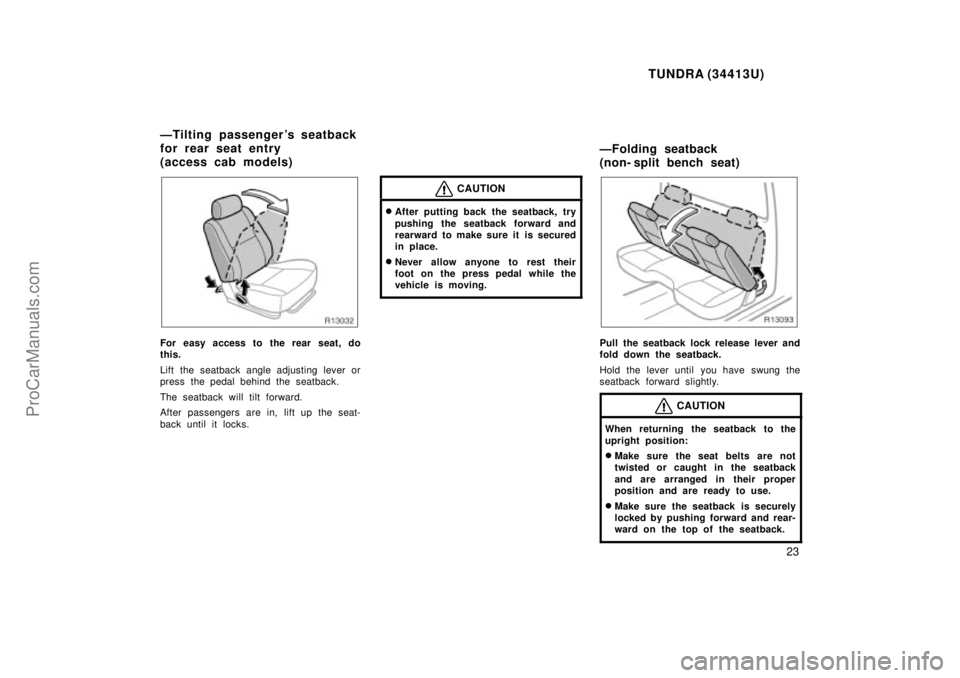
TUNDRA (34413U)
23
For easy access to the rear seat, do
this.
Lift the seatback angle adjusting lever or
press the pedal behind the seatback.
The seatback will tilt forward.
After passengers are in, lift up the seat-
back until it locks.
CAUTION
�After putting back the seatback, try
pushing the seatback forward and
rearward to make sure it is secured
in place.
�Never allow anyone to rest their
foot on the press pedal while the
vehicle is moving.
Pull the seatback lock release lever and
fold down the seatback.
Hold the lever until you have swung the
seatback forward slightly.
CAUTION
When returning the seatback to the
upright position:
�Make sure the seat belts are not
twisted or caught in the seatback
and are arranged in their proper
position and are ready to use.
�Make sure the seatback is securely
locked by pushing forward and rear-
ward on the top of the seatback.
ÐTilting passenger 's seatback
for rear seat entry
(access cab models)ÐFolding seatback
(non- split bench seat)
ProCarManuals.com
Page 25 of 283
TUNDRA (34413U)
25
1. Stow the rear seat belt and bucklesas shown in the illustration.
This prevents the belt and buckles from
falling out when you swing up the rear
seat.
NOTICE
The seat belt and buckles must be stowed before you swing up the rearseat.
2. Raise the bottom cushion while pushing the lock release lever.
CAUTION
When returning the bottom cushion to
its original position:
�Make sure the seat belts are not
twisted or caught under the bottom
cushion and are arranged in their
proper position and are ready to
use.
�Make sure the bottom cushion is
securely locked by trying to pull up
the edge of the bottom cushion.
Failure to do so will prevent seat
belt from proper operation.
Swing- up rear seats
(access cab models)
ProCarManuals.com
Page 26 of 283
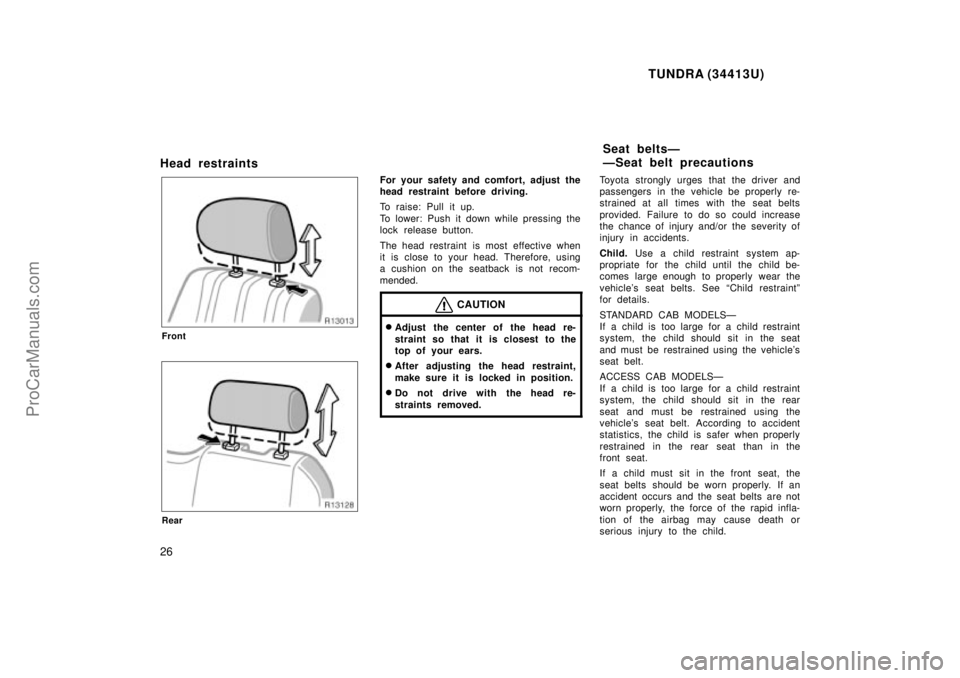
TUNDRA (34413U)
26
Head restraints
Front
Rear
For your safety and comfort, adjust the
head restraint before driving.
To raise: Pull it up.
To lower: Push it down while pressing the
lock release button.
The head restraint is most effective when
it is close to your head. Therefore, using
a cushion on the seatback is not recom-
mended.
CAUTION
�Adjust the center of the head re-
straint so that it is closest to the
top of your ears.
�After adjusting the head restraint,
make sure it is locked in position.
�Do not drive with the head re-
straints removed.
Toyota strongly urges that the driver and
passengers in the vehicle be properly re-
strained at all times with the seat belts
provided. Failure to do so could increase
the chance of injury and/or the severity of
injury in accidents.
Child. Use a child restraint system ap-
propriate for the child until the child be-
comes large enough to properly wear the
vehicle's seat belts. See Child restraintº
for details.
STANDARD CAB MODELSÐ
If a child is too large for a child restraint
system, the child s hould sit in the seat
and must be restrained using the vehicle's
seat belt.
ACCESS CAB MODELSÐ
If a child is too large for a child restraint
system, the child s hould sit in the rear
seat and must be restrained using the
vehicle's seat belt. According to accident
statistics, the child is safer when properly
restrained in the rear seat than in the
front seat.
If a child must sit in the front seat, the
seat belts should be worn properly. If an
accident occurs and the seat belts are not
worn properly, the force of the rapid infla-
tion of the airbag may cause death or
serious injury to the child.
Seat beltsÐ
ÐSeat belt precautions
ProCarManuals.com